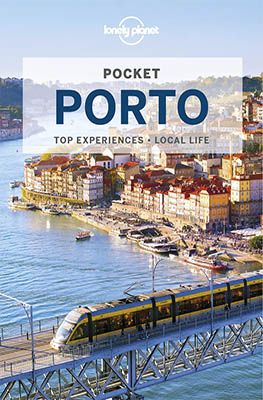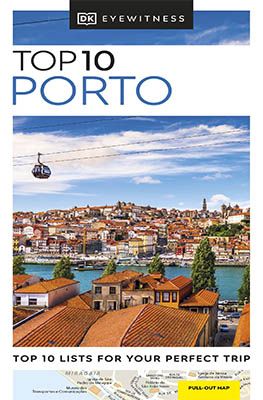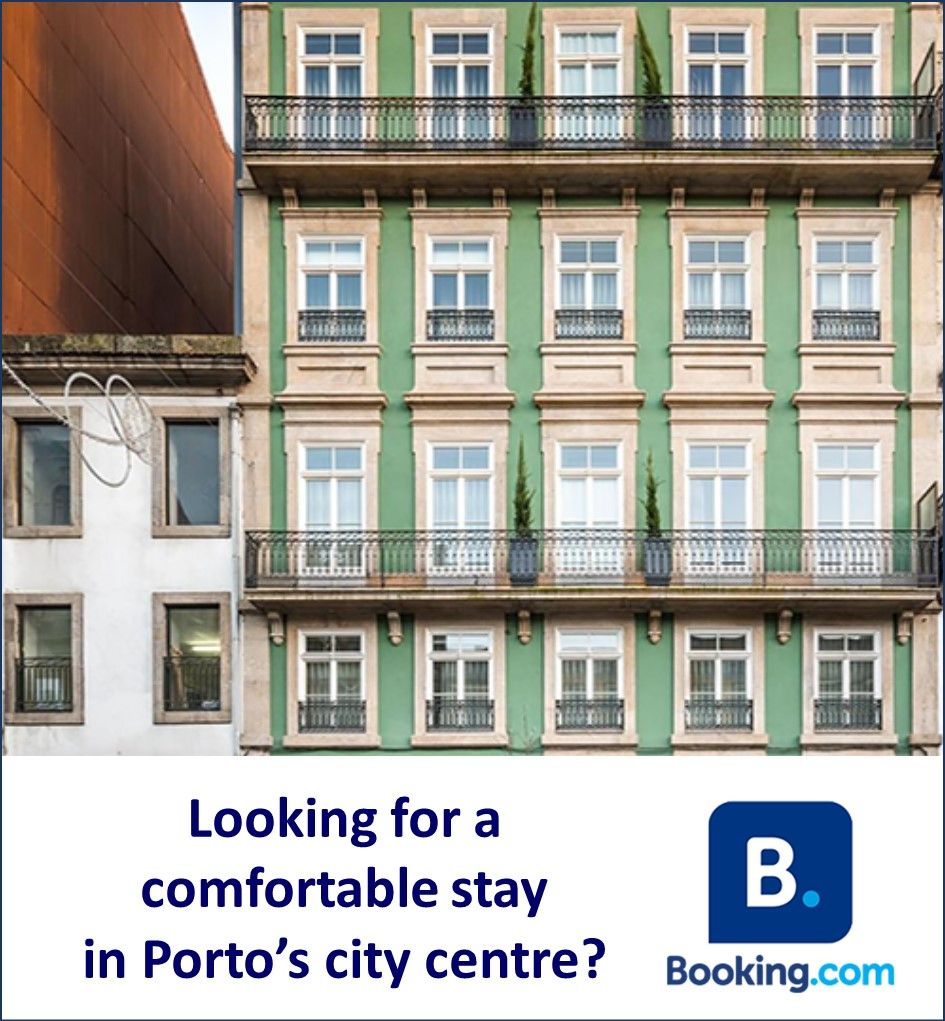Avid city trippers, foodies and culture buffs will not get easily bored of bustling Porto. The picturesque northern Portuguese city on the Douro River is famous for its Port wine. But more so for its beautiful medieval centre, which is a UNESCO World Heritage Site. Here you will find a maze of narrow, winding, cobbled streets. And centuries-old buildings that still bear witness to a rich cultural past. All this against a hilly backdrop with beautiful views of the Douro and its many bridges. In this blog, we describe some of the many highlights in and just outside Porto.
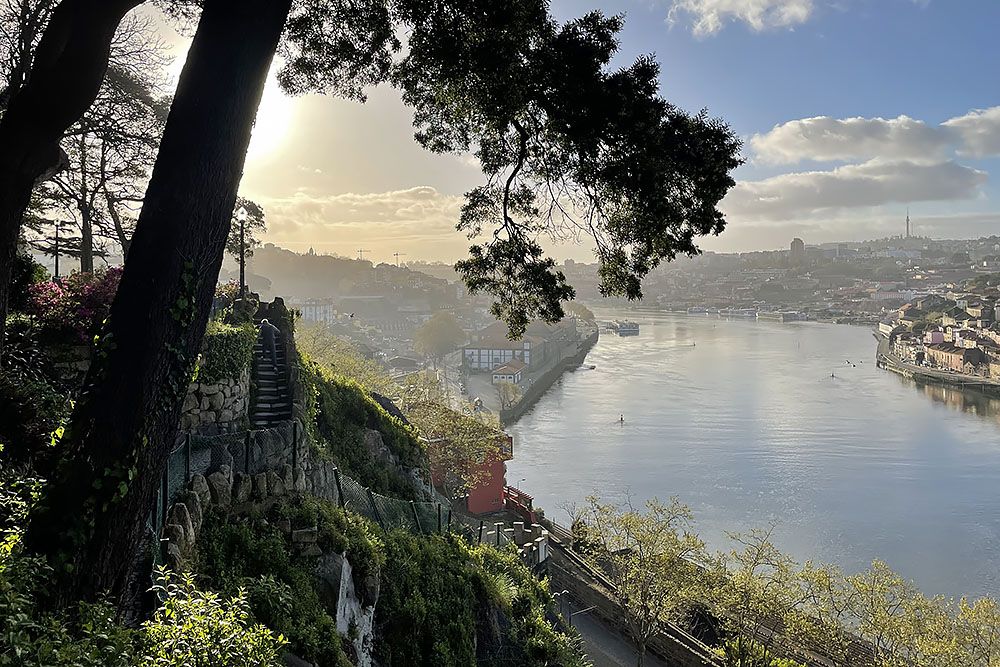
City trip to Porto: where to start?
On a city break, we like to take a guided bike tour on the first day. For us, it is an ideal way to get a good impression of the city. Besides, we learn a lot of interesting facts about the place from the guide. When we start visiting some of the highlights on our own, we know our way around.
In Porto, we did this with Baja Bikes. Accompanied by a guide who has lived there for 14 years, we got to hear a lot about the city. About its history, but also about this century’s Porto. In just over three hours, we did the main highlights of Porto. And because it is quite hilly in this port city, all in comfort with an e-bike! Our guide took us to many special places. We pick out some of the highlights along the route for you:
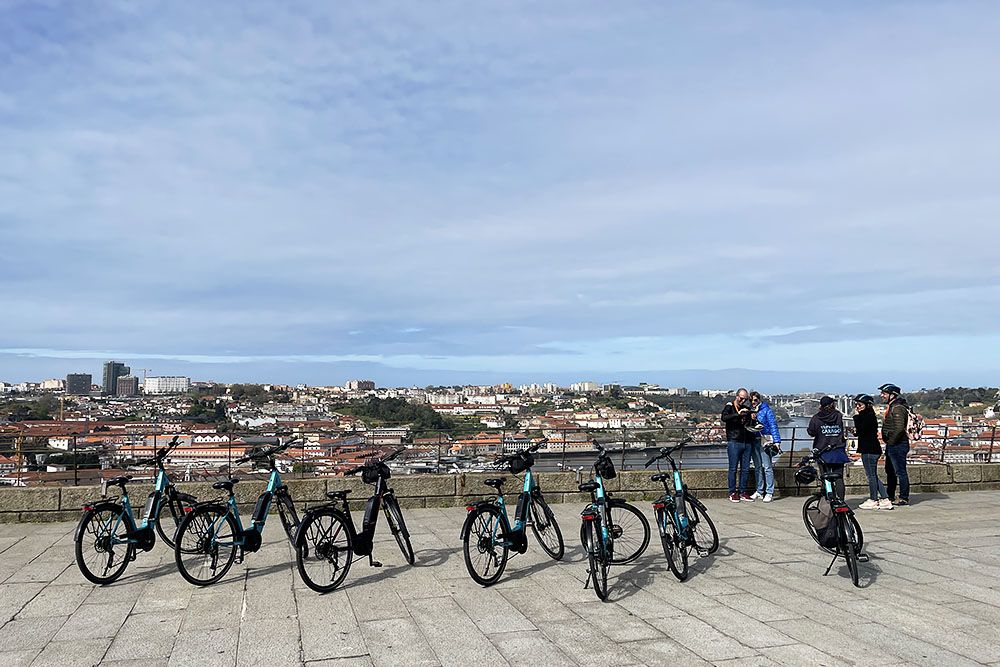
Monastery Serra do Pilar
The first place we stop for an explanation is on the north bank of the Douro. The view of the river and the built-up slopes is fantastic. In the depths, we see boats passing under the many bridges over the Douro. On the opposite side is Vila Nova de Gaia, where the Romans built their first settlement. Our guide points to a white, historic building in Gaia. It is the Serra do Pilar monastery, the first attraction on the route. With our e-bike, we then cross the Douro via a rather high bridge.
A little later, we arrive at the old monastery from the mid-16th century. Due to lack of money and the political situation (Spain had taken Portugal at the time), construction took more than 70 years. Due to its strategic hilltop location, the building temporarily became a fortress in 1832. Since then, the monastery has fulfilled religious, cultural and military functions.
Unfortunately, we could not go in as there was a wedding going on. A pity, because from what we understand, the interior must be very special. Fortunately, our visit to this location was certainly not in vain: from the hill we got an unprecedented view of Porto!
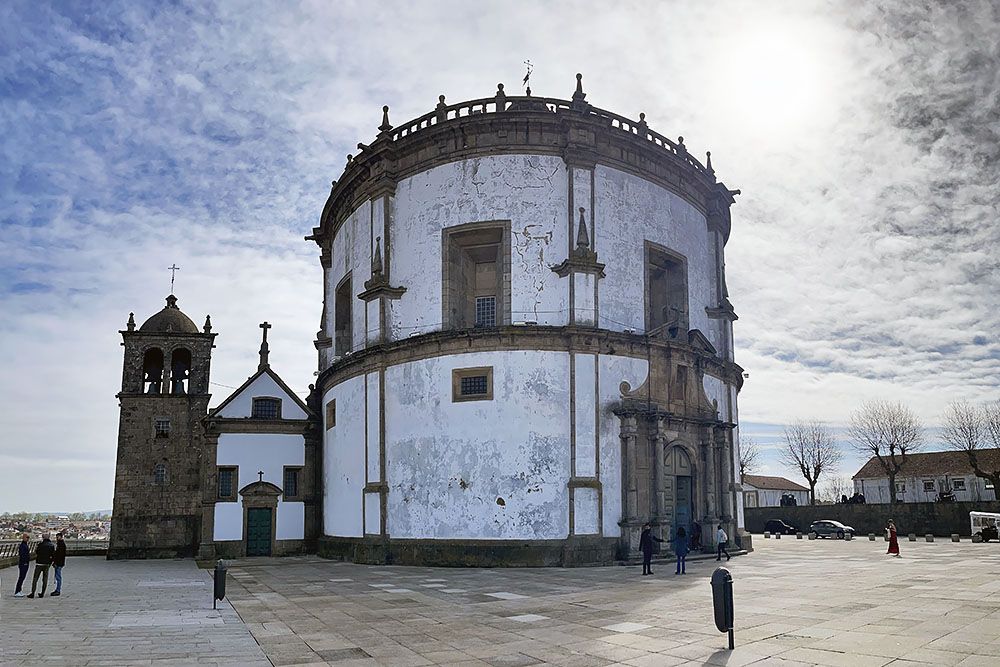
The Dom Luis 1 bridge
Our visit to Vila Nova de Gaia is short-lived. Right after the monastery, we already take another bridge to the other side. But the bridge we cycle over now is a sight in itself. The steel arch bridge from the 1880s was designed by Théophile Seyrig. The German-born engineer co-founded Eiffel et Cie with Gustave Eiffel. He mainly designed viaducts but thus also this bridge. The special thing about the bridge is that there is a lower and an upper deck. We take the lower deck with the e-bike.
Later during the city break, we walk on the upper deck. This is 44 metres higher than the lower. The view from here of the Cais da Ribeira is dizzying.
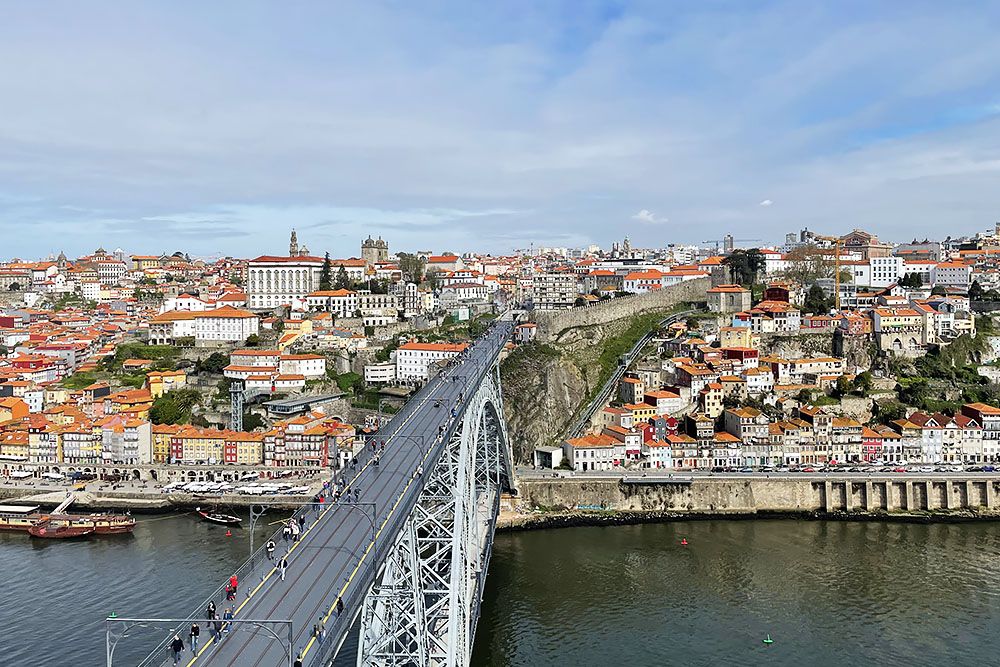
Cais de Ribeira
Once across, we follow the quay (Cais) of the Ribeira: Porto’s picturesque, quaint old town. This district is one big open-air museum. You’ll find many impressive sights, colourful houses, quaint shops and cosy restaurants and bars. The quay itself also looks particularly nice. Today is market day. Locals and tourists alike stroll inquisitively past the stalls.
By March standards, the weather in Porto is good today. The terraces are well filled with day-trippers partly for this reason. They are enjoying the spring sunshine, and the passing brass band that parades past happily. Incidentally, our guide tips us not to have lunch here on the quay. For half the price, it’s better to eat a little higher up the hill. We decide to take her advice.
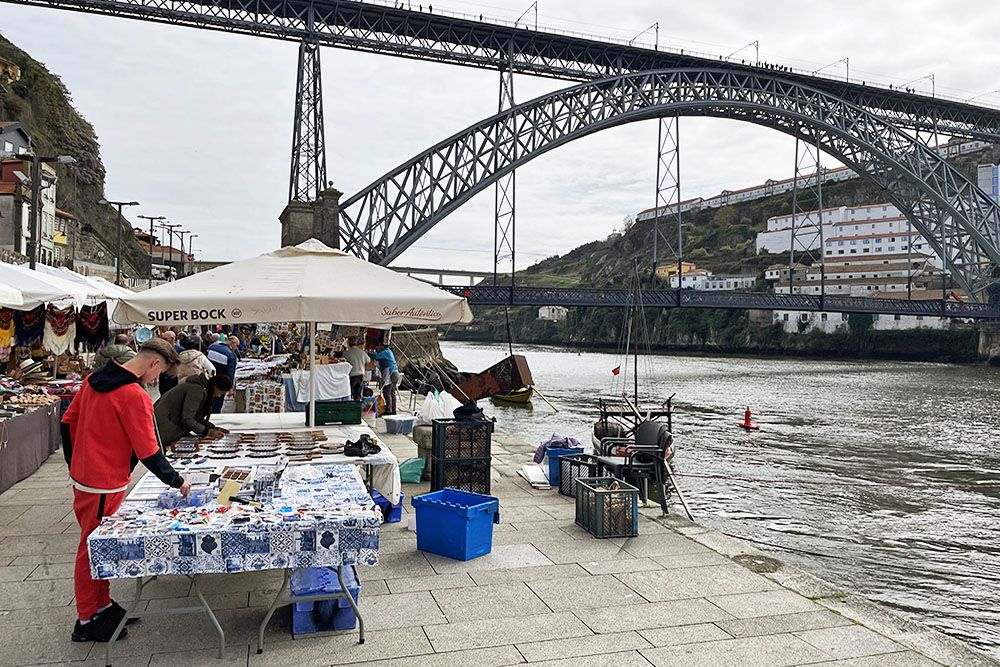
Miragaia
Our bike ride continues partly on a tramway to the Miragaia district. Periodically, we have to pull over to let the idyllic-looking historic tram 18 pass. The guide gratefully uses these moments to tell us more about Miragaia. This district used to flood regularly during inundations from the Douro River. To keep people safe and dry, the houses were built on high arches and pillars.
Miragaia’s colourful houses are tall and narrow. We could see laundry hanging from the balconies, which would no doubt dry quickly with such sun. And, as in Ribeira, the cast-iron balconies here are richly decorated with flowering plants. In that respect, Miragaia is a lot like neighbouring Ribeira. But virtually without tourists. What a lovely place!
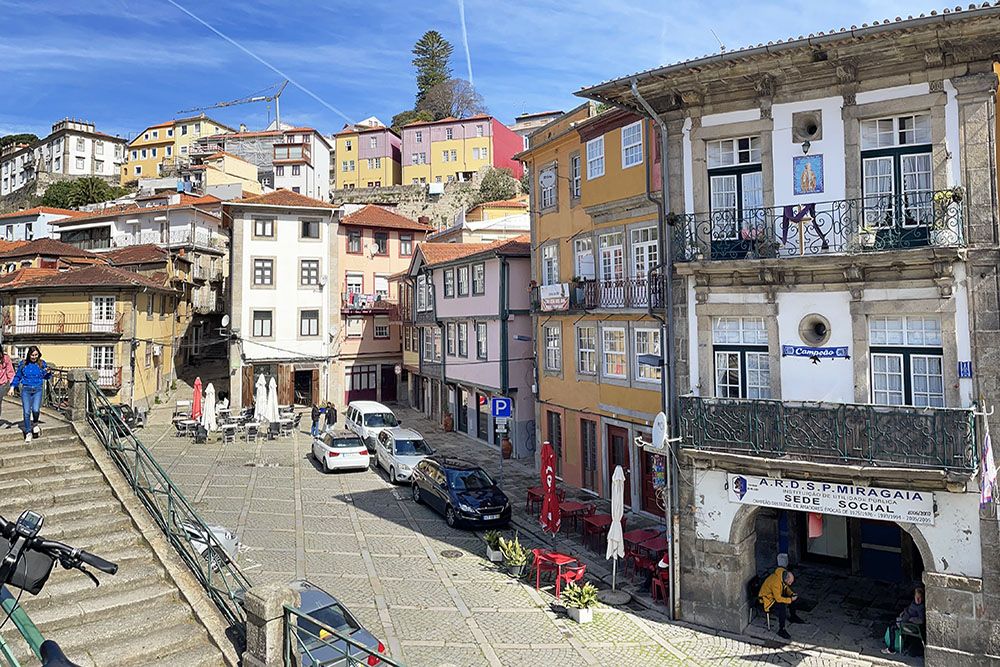
Miradouro da Vitória
From the guide we are advised to put our e-bike in turbo because as soon as we leave the quay behind it is a steep climb towards the Palácio de Cristal. We pass several pretty gardens and eventually arrive at Miradouro (viewpoint) da Vitória. A good thing our guide brought us here because we would never have found it ourselves. Once again, the view is stunning though completely different from the previous viewpoints on the route. Here we can see some of Porto’s main landmarks rising above the patchwork of red roofs. Like the Dom Luis 1 bridge, the cathedral and the bishop’s palace, as well as the quay of Gaia and the port houses in Gaia. The place was used in the early 19th century during the siege of Porto by the Liberal army.
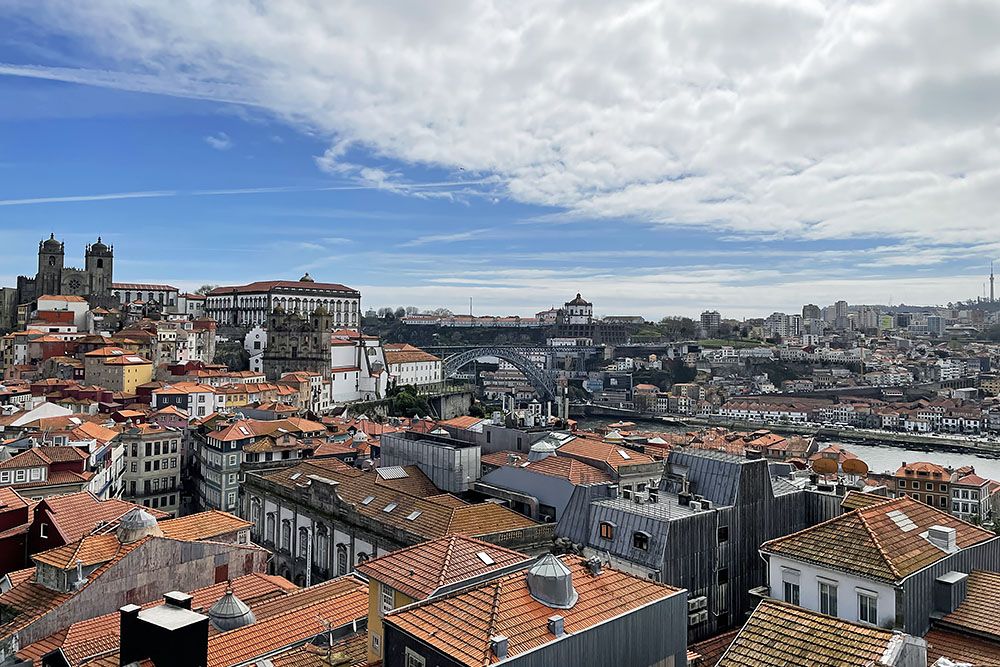
Jardim da Cordoaria
The route then leads to the little park Jardim da Cordoaria (officially: Jardim de João Chaga). This is familiar territory for us as the previous evening we had gone out for dinner in that area. The park was created in the mid-19th century. In 2001, Porto was the cultural capital of Europe. To prepare the city well for that joyous occasion, the park was also extensively renovated. There are very special trees and unique sculptures. Including the latest work by sculptor Juan Muñoz, entitled “Thirteen Laughing at Each Other”. The bronze sculptures were made to commemorate the liberal freedom fighters executed in this park in 1829. Extraordinary, as the roguish statues encourage more laughter than contemplation.
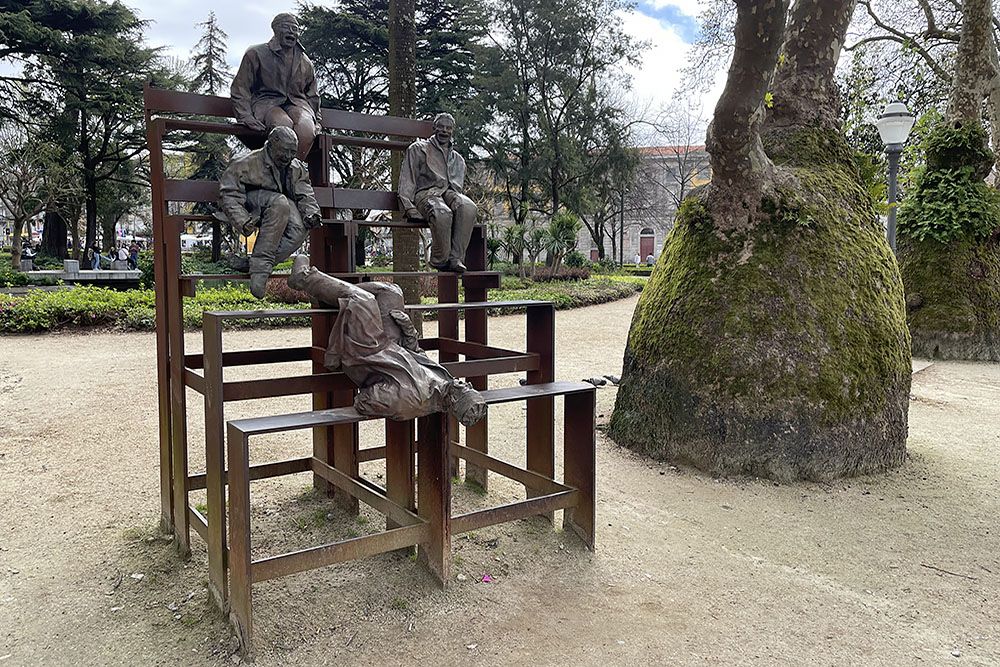
Torre dos Clérigos
Close to Cordoaria park stands the nearly 76-metre-high Torre dos Clérigos. We saw the tower of the baroque church towering above the rooftops many times during our drive. The Torre dos Clérigos is the city’s eye-catcher and calling card. The adjacent church from the mid-18th century is well worth a visit thanks to its Baroque carvings. But what should not be missing on your city break to Porto is climbing the tower. With 240 steps, this is no easy task. But once at the top, you get a great panorama of Porto and its immediate surroundings. Entrance costs 8 euros. Come as early as possible if you want to get ahead of the hordes of tourists.
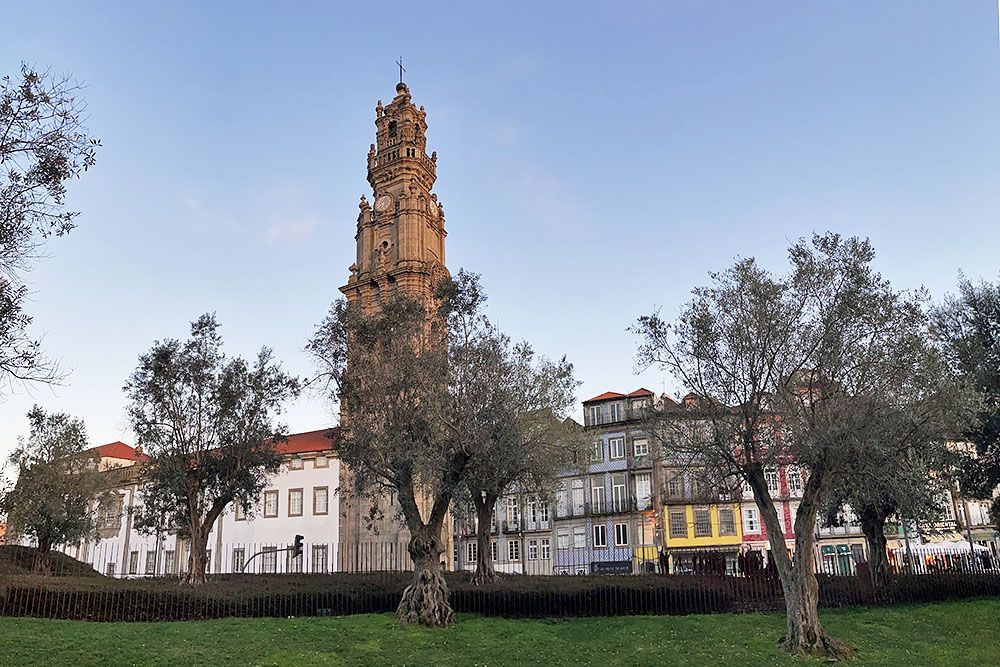
Livraria Lello
A stone’s throw from both the Jardim da Cordoaria and the Torre dos Clérigos is an unusual bookshop. In fact, the shop is so special that we see a huge queue of tourists at the door. This is Lello bookshop, which is particularly famous for its Art Nouveau architecture and fairy-tale-like interior. Especially the winding wooden staircase and the stained-glass skylight are highlights not to be missed.
The story goes that J.K. Rowling was inspired by the bookshop for parts of her Harry Potter book series. For instance, the staircase in Livraria Lello recurs as the moving staircase in Hogwarts. The children’s book author was an English teacher in Porto in the 1990s. During the bike tour, there is no time to go inside. The tip – like us – is to visit the bookshop at the end of the afternoon. Book your visit online and on time.
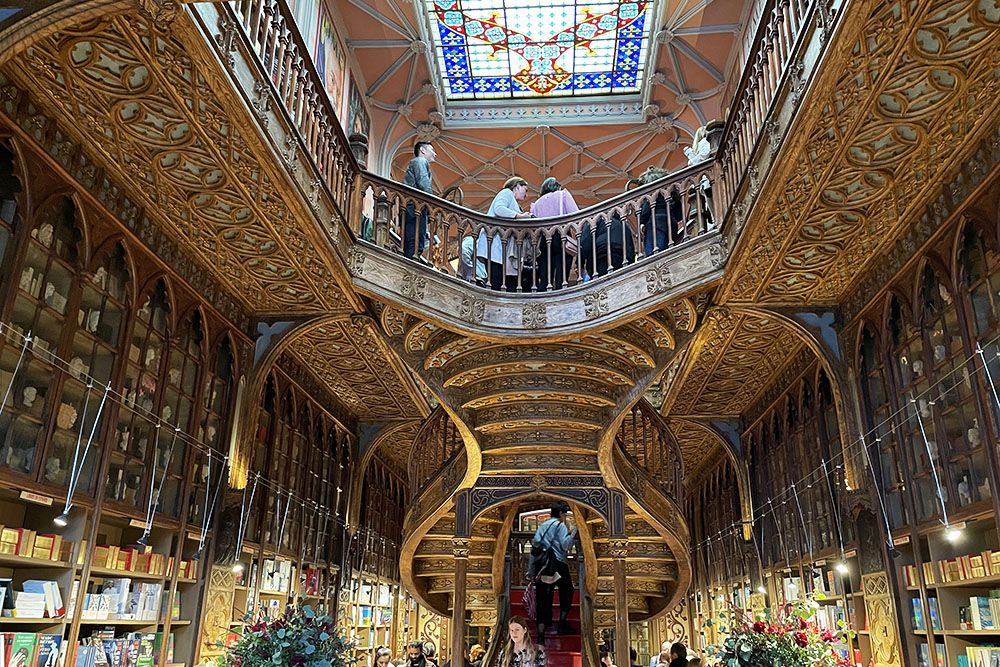
São Bento railway station
We continue the tour and arrive at the São Bento train station. While our guide keeps an eye on our bikes, we walk into the neo-classical station building. Immediately, we understand why the route passes this landmark: the building is without a doubt the most beautiful train station in Portugal! Be sure to enter here to see the beautiful atrium. The hall is decorated with no fewer than twenty thousand tiles (azulejos) illustrating important moments in Portuguese history. Each tile is hand-painted. Artist Jorge Colaço took 11 years to do it in the early 20th century. Funny detail: they had thought of almost everything when the station was built. The only thing missing on completion were the ticket offices…
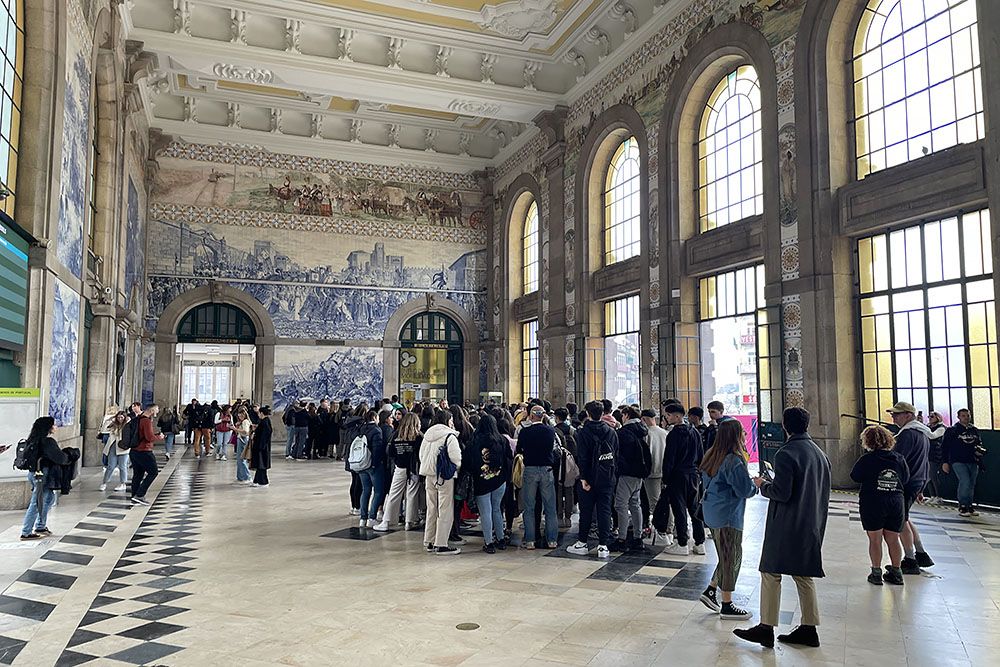
Sé, Porto’s cathedral
The last sight to see on our bike tour is Sé, Porto’s cathedral. This 12th-century cathedral is located in the highest part of the city. During the construction of this most important religious building in the city, the cathedral had a defensive function. You can still see this in the buttresses, embrasures and battlements. Over the centuries, the cathedral was repeatedly rebuilt and renovated. This explains the mixture of building styles. For instance, the house of prayer is mainly Baroque but the façade and nave are Romanesque. The cloister, on the other hand, is Gothic.
In the cathedral square is a column with four cross beams. From these, Porto’s criminals were hanged. Our guide tells us that the trial was a fun outing for the city’s residents at the time. We mostly enjoy the impressive views of the city, the Douro and Gaia on the other side of the river.
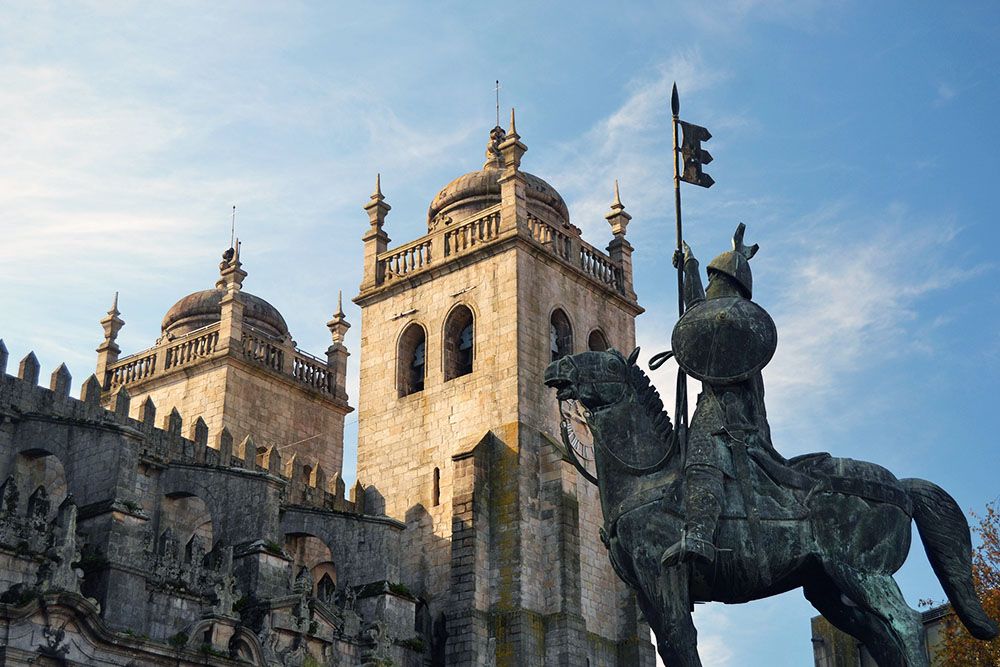
Other highlights of the Iberian City of Six Bridges
During the bike tour, you will already see many of Porto’s sights. But the city has so much more to offer. We list some other highlights you should see during your time in Porto.
Port tasting
Porto is the home of Port wine. There are many wineries around the city where the famous port wine is grown. Strictly speaking, Port may only be called port if the grapes were grown in the Douro Valley. In addition, the wine must be produced and bottled in Porto. Port wines come in many styles, such as ruby, tawny and vintage. Nowadays, you also have white port which is mainly drunk by younger generations as a trendy drink.
You will learn a lot about Port during a visit to one of the Port houses in Vila Nova de Gaia. Here you can also do a tasting. We did so at Cockburn’s. But Real Companhia Velha, Caves Sandeman and Taylor’s Port also offer a fun and interesting porter experience. Tip: from Porto, head to the port house on foot. In fact, the walk across the bridge and then through Gaia is a highlight in itself.
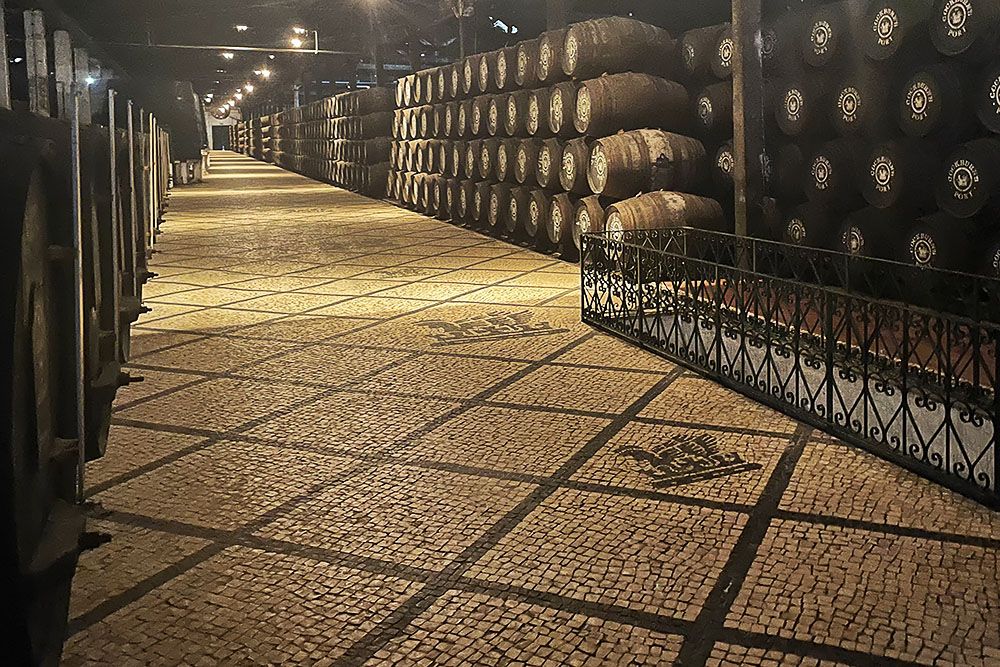
Jardins do Palácio de Cristal
To the west of the city are the gardens of the former Crystal Palace. The mid-19th-century palace was replaced a century later by the Super Bock Arena. Various cultural and sports events take place here. We visited the gardens early in the morning. Not because of the arena but purely for the beautiful park landscape. You will find narrow paths with height differences, unusual tree species, a rose garden and truly unique views.
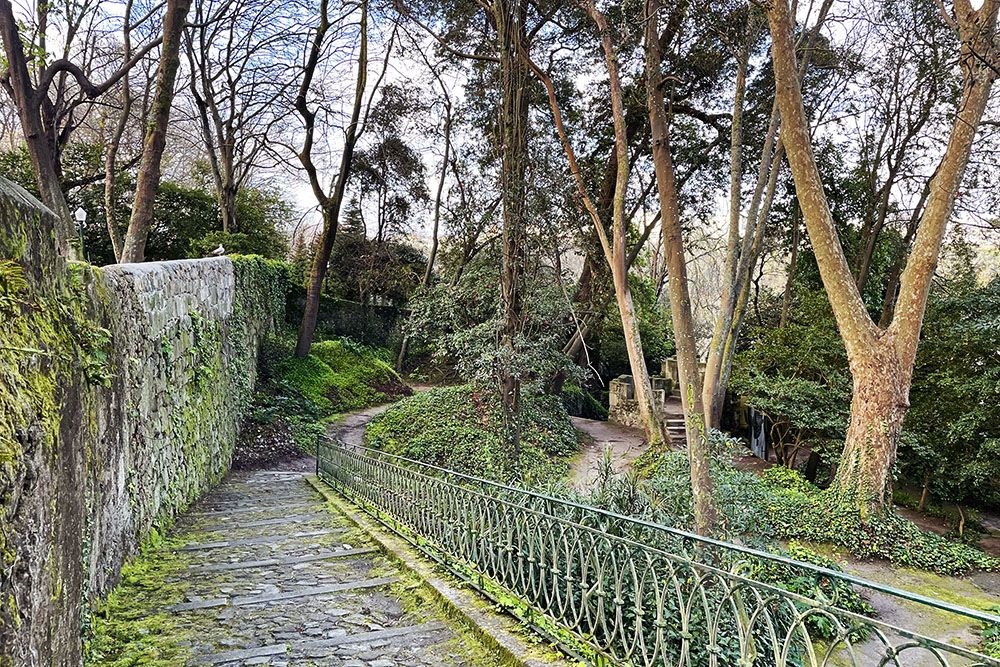
Foz do Douro
On the last day of our city break, we followed the Douro to its mouth at the Atlantic Ocean. You then end up in the charming seaside town of Foz do Douro. Don’t expect Bournemouth with dozens of beach bars here. However, you do have a beautiful, long promenade with palms and pines. And many cosy restaurants with terraces where you can go for a good lunch. It is an exceptionally nice place for a stroll beside the water.
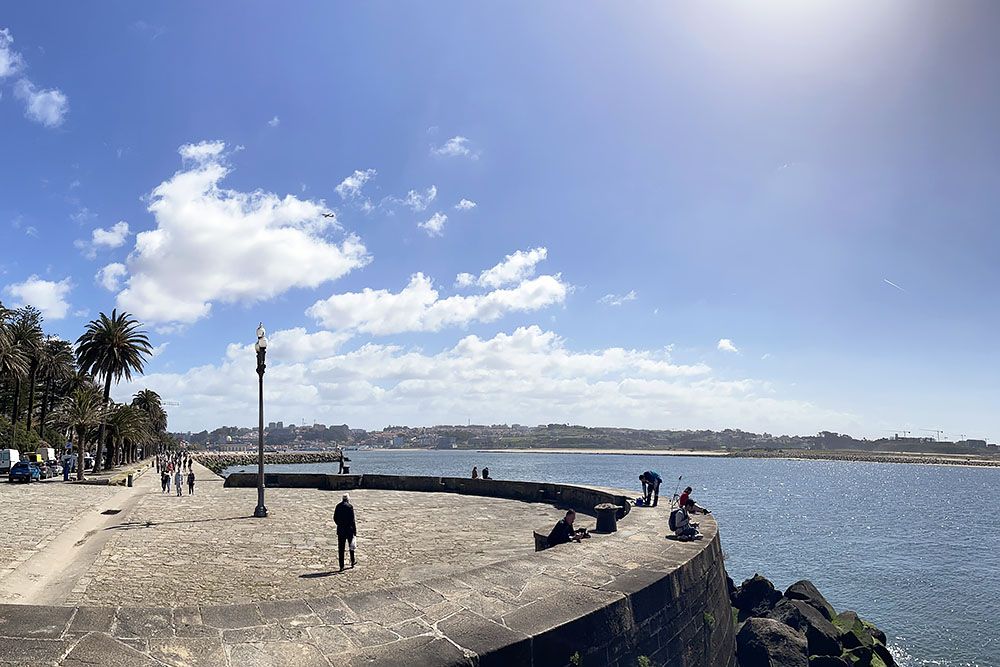
Cruise on the Douro
A unique way to admire Porto is from the water on a Rabelo. A Rabelo is a traditional Portuguese cargo boat used to transport barrels of Port to Porto. Around the Cais da Ribeira (the north quay of the Douro), one-hour tours are offered for around 15 euros. During the cruise on the Rabelo, you’ll pick up a lot of interesting facts about the city and about Port. But it is mainly the trip itself under the six high bridges that makes the cruise a must!
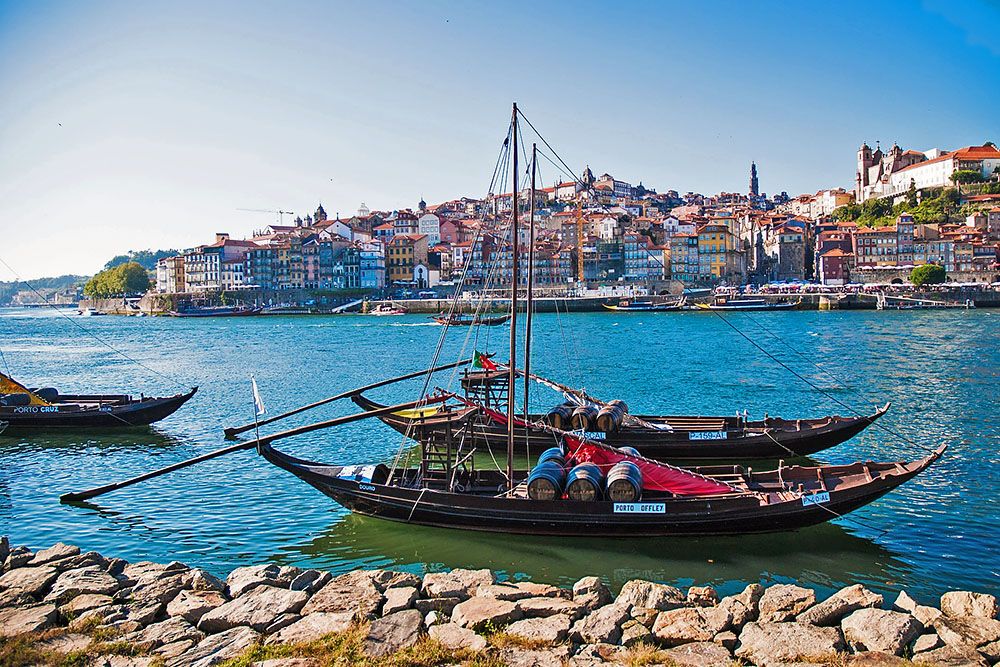
Practicalities for your city break to Porto
Porto, like Lisbon, has a temperate, fairly warm maritime climate. The best months for a city break to the City of Bridges are from May to September. Temperatures are pleasant then and rainfall is relatively low. During the winter months, the rainfall is particularly heavy and the city appears gloomy. Incidentally, we were there at the end of March and had sunny weather. At night it was quite chilly.
If you stay in the centre of Porto, most sights are within walking distance. But even more than in Lisbon, it is quite hilly. If you plan to see a lot of the city in a day's time, hire an e-bike. Or use one of the three historic trams through the city, or the tourist hop-on-hop-off bus. For longer distances, the metro is a good choice. The metro network is modern and extensive. You can also take it to the airport.
If you plan to visit many museums inside and outside the city centre, you're better off buying the Porto Card. This also gives you free public transport travel. Occasionally going to travel a bit farther? Then consider taking an Uber. Especially cheap and extremely efficient!
Most cafés and terraces can be found in Ribeira (the old town) or just outside. Especially in the immediate vicinity of the Torre dos Clérigos you will find many nice places to have a drink. Tip: the Jardim das Oliveiras (olive grove) right next to the Torre dos Clérigos has a lovely terrace for lounging. Just north of this, by the way, you also have the very relaxed rooftop bar Graça.
We heard from our bike tour guide that the inhabitants of Porto are nicknamed Tripeiros: tripe eaters. The story behind this goes back to the early 15th century. In 1415, the Portuguese war fleet sailed from Porto to North Africa to take the city of Ceuta. But the crew was short of food and especially meat. The inhabitants of the city then donated the meat, leaving themselves with only the entrails. From this they made soup. Over the centuries, this dish continued to develop into a gastronomic speciality of the city: "Tripas a moda do Porto". Nowadays, the dish is also known as "Dobrada" in the rest of the country. You can find it on the menu at most Portuguese restaurants.
Don’t fancy tripe? Don't worry because just like in Lisbon (and as far as we are concerned, actually all of Portugal), culinary delights abound in Porto. There are no fewer than seven restaurants with one or two Michelin stars. And another 13 restaurants have an entry in the Michelin Guide. But in addition to these restaurants, you can often find excellent options in the more backward establishments.
Traditional Portuguese restaurants are widespread in the narrow streets of the old town. However, avoid the tourist traps right on the Douro (Cais da Ribeira). Check here for a list of the best restaurants in Porto.
Flats can be found all over the city. There are also many three-star hotels at really affordable prices. We were in a comfortable flat north of the old town. Very pleasant though the area itself was uninspiring and certainly not that charming. In addition, it was located a fairly long walking distance from the city centre. In that respect, our tip is to look for something in the Ribeira district, not too close to busy roads. Check out the total list of accommodation in Porto.
We often come across this question on the internet. It is a tricky question to answer because the two cities differ quite a bit. Lisbon has just a bit more sights than Porto. In addition, the capital has a beautiful medieval centre. Perhaps even more beautiful than Porto's. But Porto wins as far as views are concerned. In Porto, it's more about living and experiencing the city. For instance, by leisurely strolling through the narrow streets. Or by tasting Port wine in one of the many Port houses in Gaia.
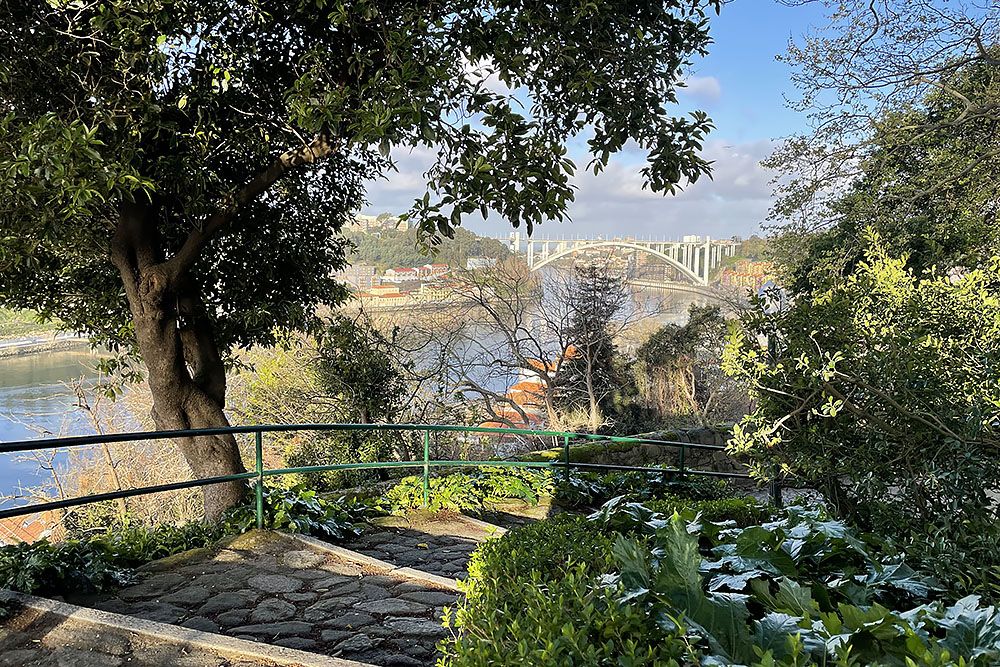
Special tours in Porto
Book special tours with our partner GetYourGuide here. We earn a modest commission for your booking at no additional cost to you. The commission helps us maintain this travel blog.

